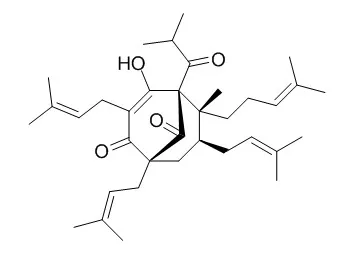| Kinase Assay: |
| Biochem Pharmacol. 2002 Dec 15;64(12):1767-75. | | Hyperforin is a dual inhibitor of cyclooxygenase-1 and 5-lipoxygenase.[Pubmed: 12445866 ] | The acylphloroglucinol derivative Hyperforin is the major lipophilic constituent in the herb Hypericum perforatum (St. John's wort). The aim of the present study was to investigate if Hyperforin as well as extracts of H. perforatum can suppresses the activities of 5-lipoxygenase (5-LO) and cyclooxygenases (COX), key enzymes in the formation of proinflammatory eicosanoids from arachidonic acid (AA).
METHODS AND RESULTS:
In freshly isolated human polymorphonuclear leukocytes stimulated with Ca(2+) ionophore A23187, Hyperforin inhibited 5-LO product formation with IC(50) values of about 1-2 microM, in the absence or presence of exogenous AA (20 microM), respectively, being almost equipotent to the well-documented 5-LO inhibitor zileuton (IC(50) = 0.5-1 microM). Experiments with purified human 5-LO demonstrate that Hyperforin is a direct 5-LO inhibitor (IC(50) approximately 90 nM), acting in an uncompetitive fashion. In thrombin- or ionophore-stimulated human platelets, Hyperforin suppressed COX-1 product (12(S)-hydroxyheptadecatrienoic acid) formation with an IC(50) of 0.3 and 3 microM, respectively, being about 3- to 18-fold more potent than aspirin. At similar concentrations, Hyperforin suppressed COX-1 activity in platelets in presence of exogenous AA (20 microM) as well as in cell-free systems. Hyperforin could not interfere with COX-2 product formation and did not significantly inhibit 12- or 15-LO in platelets or leukocytes, respectively.
CONCLUSIONS:
We conclude that Hyperforin acts as a dual inhibitor of 5-LO and COX-1 in intact cells as well as on the catalytic activity of the crude enzymes, suggesting therapeutic potential in inflammatory and allergic diseases connected to eicosanoids. | | Planta Med. 2005 Nov;71(11):999-1004. | | Hyperforin acts as an angiogenesis inhibitor.[Pubmed: 16320199] | Hyperforin is a plant compound from Hypericum perforatum that inhibits tumor cell proliferation in vitro by induction of apoptosis. Here, we report that Hyperforin also acts as an angiogenesis inhibitor in vitro and in vivo.
METHODS AND RESULTS:
In vitro, Hyperforin blocked microvessel formation of human dermal microvascular endothelial cells (HDMEC) on a complex extracellular matrix. Furthermore, Hyperforin reduced proliferation of HDMEC in a dose-dependent manner, without displaying toxic effects or inducing apoptosis of the cells. To evaluate the antiangiogenic activity of Hyperforin in vivo, Wistar rats were subcutaneously injected with MT-450 mammary carcinoma cells and were treated with peritumoral injections of Hyperforin or solvent. Hyperforin significantly inhibited tumor growth, induced apoptosis of tumor cells and reduced tumor vascularization, as shown by in situ staining of CD31-positive microvessels in the tumor stroma.
CONCLUSIONS:
These data suggest that, in addition to the induction of tumor cell apoptosis, Hyperforin can also suppress angiogenesis by a direct, non-toxic effect on endothelial cells. |
|






 Cell. 2018 Jan 11;172(1-2):249-261.e12. doi: 10.1016/j.cell.2017.12.019.IF=36.216(2019)
Cell. 2018 Jan 11;172(1-2):249-261.e12. doi: 10.1016/j.cell.2017.12.019.IF=36.216(2019) Cell Metab. 2020 Mar 3;31(3):534-548.e5. doi: 10.1016/j.cmet.2020.01.002.IF=22.415(2019)
Cell Metab. 2020 Mar 3;31(3):534-548.e5. doi: 10.1016/j.cmet.2020.01.002.IF=22.415(2019) Mol Cell. 2017 Nov 16;68(4):673-685.e6. doi: 10.1016/j.molcel.2017.10.022.IF=14.548(2019)
Mol Cell. 2017 Nov 16;68(4):673-685.e6. doi: 10.1016/j.molcel.2017.10.022.IF=14.548(2019)